PCM 1/32 Tempest V, series II
|
KIT #: |
32016 |
|
PRICE: |
$74.95 SRP
|
|
DECALS: |
Five options |
|
REVIEWER: |
Tom Cleaver |
|
NOTES: |
Short run kit |
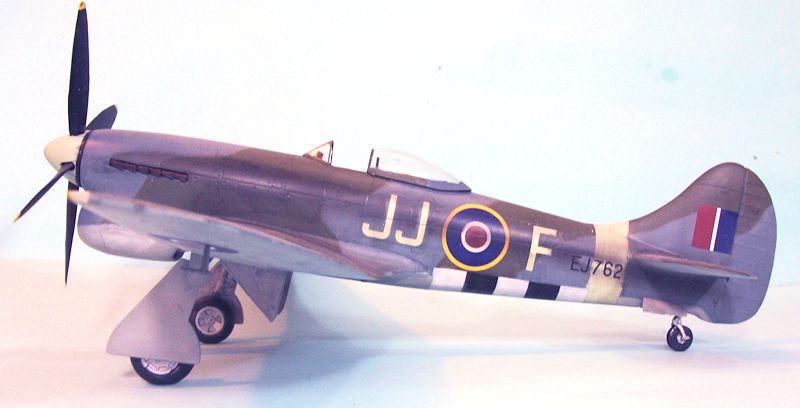
When Sydney Camm first designed what became the Typhoon in the late
1930s, not that much was known about high speed flight and heavy weaponry, with
the result that the Typhoon’s wing turned out to be too thick.
The result was that Camm began working on the P.1012, known as the
Typhoon II, which would feature a thinner wing.
In March 1940, it was decided to adopt a NACA “laminar flow” airfoil with
a maximum thickness-to-chord ratio of 14.5% at the root, 10% at the tip.
The wingspan was originally greater than that of the Typhoon but was
clipped to 41 feet, two feet shorter than the Typhoon, with an elliptical wing
shape to provide room for 200 r.p.g. for each of the four 20mm cannon the
airplane would carry. The new
design was finalized by October 1941; the Air Ministry issued specification
F.10/41, been written to fit the aircraft. In February 1942 the name became
officially Tempest.
The first Tempest prototype flew on September 2, 1942.
Initially, it was not as maneuverable as expected, but when the ailerons
were modified with spring-loaded trim tabs, maneuverability was outstanding.
In tests with Allied and captured enemy types, it outperformed the
Mustang and Spitfire
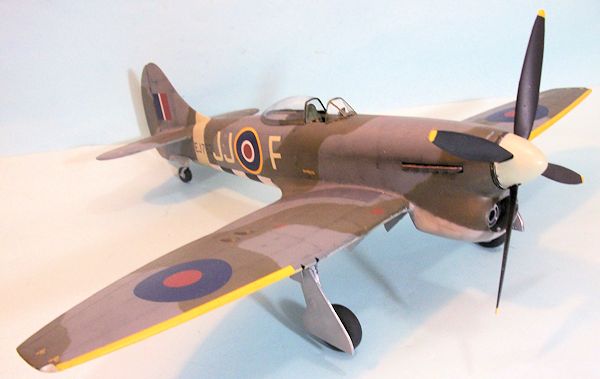 below
20,000 feet and only the Fw-190a could out-roll it.
Below 22,000 feet, it was the fastest Allied fighter of the war, capable
of 376 mph at 1,000 feet, with a top speed of 435 mph at 20,000 feet. Engine
problems led to cancellation of other versions and finally, on June 21 1943 the
first Tempest V, powered by the 2,235 h.p. Sabre IIA series engine, took flight.
The first 100 “Series I” aircraft had long-barreled 20mm cannon that
extended beyond the leading edge of the wing; all subsequent “Series II”
aircraft used short-barreled weapons that did not. The Ejxxx and subsequent
Series II aircraft used the Sabre IIB engine providing 2,400 h.p. Interestingly,
during the war the Tempest never used the gyroscopic gunsight used by the
Spitfire and Mustang.
below
20,000 feet and only the Fw-190a could out-roll it.
Below 22,000 feet, it was the fastest Allied fighter of the war, capable
of 376 mph at 1,000 feet, with a top speed of 435 mph at 20,000 feet. Engine
problems led to cancellation of other versions and finally, on June 21 1943 the
first Tempest V, powered by the 2,235 h.p. Sabre IIA series engine, took flight.
The first 100 “Series I” aircraft had long-barreled 20mm cannon that
extended beyond the leading edge of the wing; all subsequent “Series II”
aircraft used short-barreled weapons that did not. The Ejxxx and subsequent
Series II aircraft used the Sabre IIB engine providing 2,400 h.p. Interestingly,
during the war the Tempest never used the gyroscopic gunsight used by the
Spitfire and Mustang.
The Tempest entered service in April 1944 with 3 and 486 Squadrons with
56 Squadron attached in May as 150 Wing, led by Wing commander Roland Beamont,
who had taken the first Typhoon unit into combat and had been involved over the
previous year in testing and development of the Tempest as Hawkers.
The Tempest first saw combat on July 8, 1944 over Normandy, but soon
after the Germans launched V-1 “buzz bomb” attacks against London and Southern
England, and the Tempest as the fastest low-medium altitude fighter was held
back to defend against this weapon.
The Tempests were responsible for 636 of 1,846 V-1s destroyed by the AF by the
time the V-1 launch sites were overrun in September.
3, 274, 80, 56 and 486 (RNZAF) Squadrons moved to the Continent on
September 21, 1944, replacing the Mustang III squadrons in 122 Wing.
Soon based at Volkel in Holland, the Tempests were used for “armed
reconnaissance,” - low level attack, strafing trains and other transport - as
well as air superiority, taking on the Luftwaffe frontline fighter units.
In February 1945, 222 and 33 Squadrons of 135 Wing converted to the
Tempest and were joined by 274 Squadron.
52 German fighters were shot down during December 1944, with 89 trains
destroyed, for the loss of 20 Tempests. Following the Operation Bodenplatte of 1
January 1945, 122 Wing bore the brunt of low to medium altitude fighter
operations for the 2TAF Tactical Air Force, with Spitfire XIVs of 125 and 126
Wings often providing medium to high altitude cover for the Tempests. The Wing
lost 47 pilots in January, 1945.
Throughout the period from January to March, 1945, Tempests flew “rat
scrambles,” particularly over the
Me 262 and Ar 234 base at Rheine‑Hopsten, to catch jets that were most
vulnerable during take-off and landing.
Luftwaffe pilot Hubert Lange said,
"The Messerschmitt Me 262's most dangerous opponent was the British
Hawker Tempest — extremely fast at low altitudes, highly‑maneuverable and
heavily‑armed." After seven
Tempests were lost to flak at Rheine‑Hopsten in a single week, the "Rat
Scramble" was
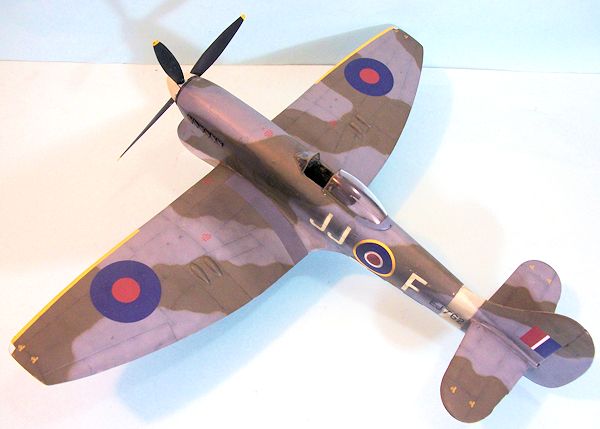 discontinued.
In air‑to‑air combat, the Tempest units shot down 239 German aircraft between
November 1944 and the end of the war, achieving an estimated air combat success
ratio of 7:1 while accomplishing a 6:1 ratio against single seat enemy fighters.
discontinued.
In air‑to‑air combat, the Tempest units shot down 239 German aircraft between
November 1944 and the end of the war, achieving an estimated air combat success
ratio of 7:1 while accomplishing a 6:1 ratio against single seat enemy fighters.
“The Terror of Rheine”:
Donald Charles “Foob” Fairbanks was born in Ithaca, NY, in 1923, the son
of a professor at Cornell University, and eventually became the top-scoring
Tempest pilot of World War II, flying with the RCAF.
Fairbanks became deeply interested in aviation at a young age.
When he graduated from high school in 1940, he discovered he could not
join any U.S. air force without two years of college, so he ran away from home
and joined the RCAF in Hamilton, Canada in February 1941.
He was rewarded for the flying ability he demonstrated during his
training by an assignment as a flight instructor at 13 Flying Training Squadron
until February 1943. After
completion of advanced training in the UK, he joined 501 Squadron on December 1,
1943, flying Spitfires. He refused
transfer to the USAAF that spring of 1944, since he would only qualify as a
Flight Officer, not to mention the pay in the RCAF was superior to that of the
USAAF (the RCAF being the highest-paid air force of the war), and would be most
likely be assigned to P-47s. His first victories were scored over Normandy on
June 8, 1944, when he shot down one Bf-109 and damaged another near Le Havre.
501 transitioned to the Tempest that August, and Fairbanks transferred to
274 Squadron, one of the original units equipped with the new fighter, where he
shot down a V-1 on August 29, 1944. The move was fortunate for Fairbanks, since
501 remained in the UK on anti-diver duty against V-1s, while 274 was sent to
the Continent in September as part of 122 Wing.
274 Squadron as part of 122 Wing was stationed at advanced airfield B.80
at Volkel, Holland, which would be its main base for the remainder of the war
until it crossed the Rhine into Germany in April 1945 to be stationed at Celle.
The Tempest, being the fastest low-medium altitude fighter in the RAF,
had the assignment of direct combat with the Luftwaffe’s frontal fighting force
composed of JG 26, JG 2, JG 6 and JG 27 in western Germany.
Flying Tempest V EJ762, JJ-F, Fairbanks first demonstrated what he was
really made of as a pilot on November 19, 1944.
During a ground-strafing mission against rail transport, his Tempest was
hit by flak in the leading edge of the left wing, which set the fuel tank afire
and rolled the Tempest inverted from the impact during the low-level run-in on
the target. Flight Leader Warren
Peglar called out to find out who had been hit.
Fairbanks’ wingman, Jock Malloy, informed Peglar it was Fairbanks and
said he would lead him back to base.
In the meantime, Fairbanks, still inverted at low level, flew over the
target and then recovered, flipping the Tempest upright which put out the fire,
and headed for Volkel on his own.
By the time the rest of the flight returned, Fairbanks had already become the
subject of the famous photograph of him standing next to his badly-burned
Tempest, which had lost all the fabric from the rudder (making his recovery from
inverted flight all the more amazing for the increased difficulty).
On December 17, 1945, again in the now-repaired EJ762, Fairbanks scored
his first two Tempest victories, two Bf-109s shot down and a third damaged.
A few days later he was transferred to 3 Squadron, still in 122 Wing,
where in January he began to run
the score that would make him the top Tempest pilot.
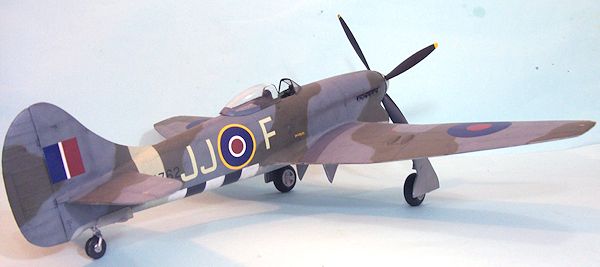 During
January 1945 he scored an Fw-190D-9 and a Bf-109G shot down, one-and-a-half
Ju-52s and two Ju-88s destroyed in strafing attacks.
During
January 1945 he scored an Fw-190D-9 and a Bf-109G shot down, one-and-a-half
Ju-52s and two Ju-88s destroyed in strafing attacks.
On February 9, 1945, by then known as “The Terror of Rheine” for the many
combats he fought in the vicinity of the major German airbase at Rheine, he
returned to 274 as Squadron Leader, replacing Squadron Leader Baird who had been
shot down in combat with JG 27 the previous day; he was still only 21 at the
time. On February 11, 1945, he
claimed one Me-262 shot down and one damaged.
The airplane he shot down was actually an Ar-234B-1 (W.Nr. 140149) coded
"4U+DH" of 1.(F)/123 flown by Hans Felder; Fairbanks was the first to shoot down
one of these aircraft. In four
other combats over the rest of the month, he shot down two more Bf-109s and four
Fw-190D-9s. On February 28,
returning with five other Tempests from a train-busting mission, he led an
attack on over 40 Fw-190D-9s and Bf-109Ks of JG 26 he spotted forming up over
the Black Forest. After a hard
fight he was finally shoot down by by Feldwebel Karl‑Georg Genth of 12./JG 26 in
an Fw 190D‑9, “Gelbe 15,” and was immediately captured, avoiding a lynch mob of
German civilians when a German officer intervened.
He spent the rest of the war as a POW, during which he was awarded a bar
to his DFC. Returning from
captivity, he claimed to have shot down a final Fw0190D-9, though this was never
officially credited; however, Luftwaffe casualty records do show a loss at the
correct time and place, a Fw-190D-9 of 9./JG 26, “Weiss 17,” flown by
Unteroffizier Franz Schmidt.
Returning to home after the war, Fairbanks obtained a degree in
engineering from Cornell and then went to work for Sperry Gyroscopes in Ontario,
and also flew Vampires and T‑33s with the RCAF Auxiliary, as well as spending
two years in the UK, where he was able to fly Meteors with 504 Squadron, RAuxAF.
In 1955 he returned to Canada to take a position as a test pilot at deHavilland
Canada where he worked with former RCAF Spitfire pilot Jerry Billings, testing
the Beaver, Otter and Caribou. At Avro Canada he became an expert in STOL
flight. He died a natural death at the early age of 52 in 1975.
His score of one V-1, 11 aerial victories and four ground victories in
the Tempest made him the top Tempest pilot of the war.
Kits of the Tempest V have been thin on the ground.
Matchbox and Heller produced 1/72 kits back in the early 1970s, with the
Matchbox kit convertible to a Tempest II, while AMT released a 1/48 Tempest in
around 1976 that needed a lot of work to become a good model.
In 1998, Eduard released a 1/48 Tempest V, which also had a lot of
mistakes but was the best kit of this airplane available.
This kit by Pacific Coast Models in 1/32 is the first time the Tempest
has been done in this scale. The
project benefitted from input
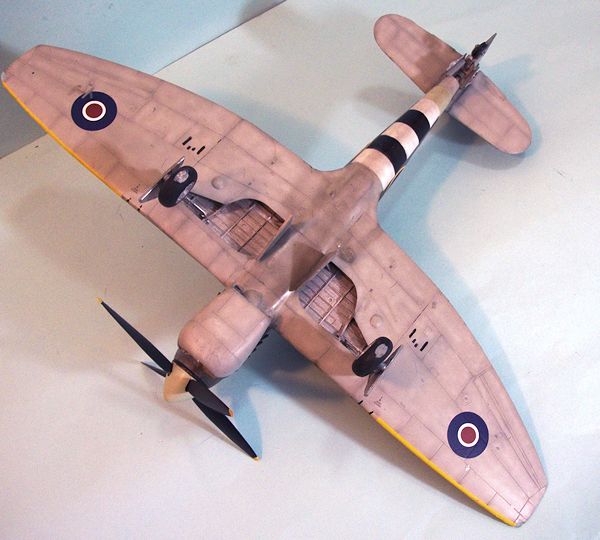 from
kitmaker and Tempest expert Roy Sutherland and Tempest historian Chris Thomas,
with the result that it is the first completely dimensionally-accurate kit of
this airplane. Interestingly enough, after never having a 1/32 Tempest, there
are now about to be two kits, with Special Hobby releasing a 1/32 kit that can
be made as a radial-engined Tempest II, or the Sabre-powered Tempest V and VI.
from
kitmaker and Tempest expert Roy Sutherland and Tempest historian Chris Thomas,
with the result that it is the first completely dimensionally-accurate kit of
this airplane. Interestingly enough, after never having a 1/32 Tempest, there
are now about to be two kits, with Special Hobby releasing a 1/32 kit that can
be made as a radial-engined Tempest II, or the Sabre-powered Tempest V and VI.
This is a limited-run kit produced for PCM by Sword, and is similar to
their previous releases for PCM like the Re. 2005, Hurricane, and Spitfire XIV.
The kit does seem to me to be a bit more primitive in terms of production
quality than the other PCM kits, with numerous ejection towers to be cut off
parts in strange places, though overall quality is excellent for a limited-run
kit. Cartograf decals cover five
different Tempest Vs flown during the war and shortly after, and are of
excellent quality, with all versions of national insignia used by the airplane
during its service, and complete stencils.
I was surprised that the decals did not cover aircraft flown by some of
the more prominent Tempest pilots, such as David “Foob” Fairbanks, the top
Tempest ace, or Pierre Clostermann; perhaps these markings will appear in the
other kit.
There is one Major Problem with the kit, which I discovered the hard way.
That is that the plastic parts for the radiator faces are slightly too
large. If you do not reduce them in
size, fit of the lower cowling of the fuselage will be problematic, and will
result in a lot of industrial-strength pushing and shoving to get it together
and then mate the fuselage to the wing, not to mention you will use a lot of
putty and sanding sticks getting the poor fit to finally look right, and in the
end SWMBO will Severely Admonish you for the crime of using Inappropriate
Language Around Children.
You can avoid this problem completely by sanding down these parts by
about 1/32 inch all the way around, and then cutting down the photoetch radiator
faces to fit. Do not worry if the
end result is these are now a bit undersized, since when the cowling is closed
up, you will not be able to tell.
What you will accomplish by doing this is ensure excellent fit for the fuselage,
and no problem in joining the fuselage to the wing sub-assembly.
 Keep in mind that this is a limited-run kit; you will use putty and
filler on all joints, and then you will need to rescribe lost detail.
None of this should present any problem to anyone who has done at least
one other limited-run model successfully.
Keep in mind that this is a limited-run kit; you will use putty and
filler on all joints, and then you will need to rescribe lost detail.
None of this should present any problem to anyone who has done at least
one other limited-run model successfully.
The cockpit is nicely detailed.
Be sure to put the side panels onto the side frames before further
assembly. I have been assured by
the Tempest Boffins that the instruction to paint the cockpit British Interior
Green is right. At later points,
the upper part of the cockpit, and all of some cockpits, were overpainted with
black, but no one knows which ones.
Thus, you can do it all green or do the upper part in black, which I would
personally limit to those airplanes operating toward the end of the war and just
afterwards. The pre-painted
photoetch detail by Eduard is very nice.
I managed to drop several of the little handles and levers, so didn’t use
any. Given that the cockpit opening
is small, most viewers of the completed model will never notice their absence.
When it came time to assemble the spinner, I found that the short-chord
(blunt) spinner doesn’t fit the backplate and prop blades right without a lot of
cutting and trimming where the blades are supposed to fit.
However, the long-chord spinner fits without problem.
This is a Big Problem because the blunt spinner was used on all Tempests
up to the late-war SNxxx series and not all of them used the long-chord spinner,
according to Chris Thomas (Mr. Typhoon-Tempest), and three of the five optional
aircraft thus use the short-chord spinner. You will have to do that modification
and test-fitting before you do any painting. Check photos of the airplane you
are modeling. I did the necessary
work, which is mostly in deepening the cutouts for the prop blades, since the
airplane I modeled definitely used the short-chord spinner.
It should also be noted that Pacific Coast Models has been made aware of
the fit and warp problems. Sword is
making re-sized radiator pieces, a reshaped short-chord spinner and unwarped
wings and fuselage parts which will be sent to PCM, who will make those parts
available to anyone who has purchased a kit and requests replacement.
As noted above, it is not all that difficult to solve these problems with
“some modeling skill required.”
The continuing discussion of whether British airplanes used matts for
creating camouflage patterns has heated up of late.
The instructions to this kit say that the camouflage pattern varied
slightly between aircraft. Photos
show the edges of the camouflage is not “hard edged” as on early mark Spitfires
and Hurricanes. Most likely, the
pattern was chalked on the airplane and painted with a spraygun, with the edges
done tightly. Having seen this on
full-scale restorations, from a distance of more than 10 feet (2 inches in 1/32
scale) the camouflage pattern done this way looks “hard eged.”
So I did mine freehand,
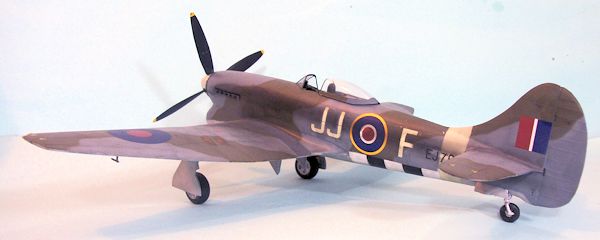 using the
camouflage pattern shown in the old Profile Publications Typhoon and Tempest
Camouflage and Markings booklet. I
used Tamiya’s RAF paints: Ocean Green, Dark Green and Sea Grey Medium, with each
lightened a bit to do post-shading.
I also painted the D-Day black/white stripes on the lower fuselage and masked
them prior to camouflage; as well the Sky band around the rear fuselage and the
yellow leading edges of the outer wings.
using the
camouflage pattern shown in the old Profile Publications Typhoon and Tempest
Camouflage and Markings booklet. I
used Tamiya’s RAF paints: Ocean Green, Dark Green and Sea Grey Medium, with each
lightened a bit to do post-shading.
I also painted the D-Day black/white stripes on the lower fuselage and masked
them prior to camouflage; as well the Sky band around the rear fuselage and the
yellow leading edges of the outer wings.
The markings options offered by the kit are very nice, but I wanted to do
one of Fairbanks’ Tempests. The
decals can be cut and modified without problem to create his first one,
EJ762/JJ-F, which I did. Should you
do this one (it’s a popular choice), do be aware that the profile in Chris
Thomas’ book is not right. Chris
has recently seen a photograph (which he showed me that I cannot show you) that
finally shows the left side of Fairbanks’ airplane from about the 8 o’clock
position, which confirms that the “JJ” did not have upturned lower tips, and
that the “F” had equal-length horizontal bars.
So, if you want to do Fairbanks’ airplane, do it as I did here.
When Fairbanks got his airplane back from the repair shop in December
1944, there was still a long streak of smoke-blackened paint down the left side
of the fuselage, which had only been wiped off the
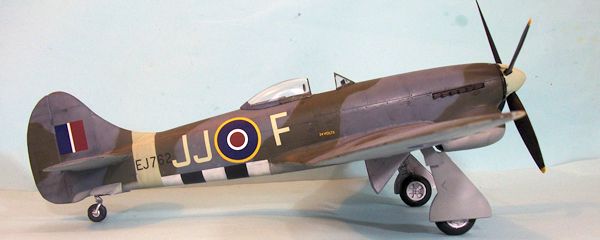 squadron
ID letters and serial number, with that over the paint and national insignia
left alone. This makes for a very
different look, and one that I decided to recreate with Tamiya “Smoke.”
Looking at the new photo Chris Thomas had shown me, I did a large smoky
strip over the fuselage, leaving the port leading edge gas tank clean since it
would have been replaced after being blown open by flak, and keeping smoke off
the rudder which would have been replaced after the fabric was burned off.
The result is a model of the airplane as it likely appeared when
Fairbanks scored his first Tempest air-to-air victories on December 17, 1944.
squadron
ID letters and serial number, with that over the paint and national insignia
left alone. This makes for a very
different look, and one that I decided to recreate with Tamiya “Smoke.”
Looking at the new photo Chris Thomas had shown me, I did a large smoky
strip over the fuselage, leaving the port leading edge gas tank clean since it
would have been replaced after being blown open by flak, and keeping smoke off
the rudder which would have been replaced after the fabric was burned off.
The result is a model of the airplane as it likely appeared when
Fairbanks scored his first Tempest air-to-air victories on December 17, 1944.
I attached the landing gear, exhaust stacks, and prop, and posed the
canopy open. At the moment, the
44-gallon drop tanks are not attached to the wing, since I couldn’t get them
finished in time for the necessary photography deadline for this review, but
they will be on the model by the time you read this.
Even with the difficulties I ran into with this project (which you can
avoid, now that you know where the “minefields” are), the end result is a
good-looking model of this important airplane.
It definitely looks good sitting next to my 1/32 Hawker Fury, Hurricanes,
Typhoon and Sea Fury. The model is
not difficult for anyone with any experience in constructing limited-run kits
and is highly recommended.
Tom Cleaver
July 2013
Review kit courtesy of www.pacmodels.com
If you would like your product reviewed fairly and
fairly quickly, please
contact
the editor or see other details in the
Note to
Contributors.
Back to the Main Page
Back to the Review
Index Page


 below
20,000 feet and only the Fw-190a could out-roll it.
Below 22,000 feet, it was the fastest Allied fighter of the war, capable
of 376 mph at 1,000 feet, with a top speed of 435 mph at 20,000 feet. Engine
problems led to cancellation of other versions and finally, on June 21 1943 the
first Tempest V, powered by the 2,235 h.p. Sabre IIA series engine, took flight.
The first 100 “Series I” aircraft had long-barreled 20mm cannon that
extended beyond the leading edge of the wing; all subsequent “Series II”
aircraft used short-barreled weapons that did not. The Ejxxx and subsequent
Series II aircraft used the Sabre IIB engine providing 2,400 h.p. Interestingly,
during the war the Tempest never used the gyroscopic gunsight used by the
Spitfire and Mustang.
below
20,000 feet and only the Fw-190a could out-roll it.
Below 22,000 feet, it was the fastest Allied fighter of the war, capable
of 376 mph at 1,000 feet, with a top speed of 435 mph at 20,000 feet. Engine
problems led to cancellation of other versions and finally, on June 21 1943 the
first Tempest V, powered by the 2,235 h.p. Sabre IIA series engine, took flight.
The first 100 “Series I” aircraft had long-barreled 20mm cannon that
extended beyond the leading edge of the wing; all subsequent “Series II”
aircraft used short-barreled weapons that did not. The Ejxxx and subsequent
Series II aircraft used the Sabre IIB engine providing 2,400 h.p. Interestingly,
during the war the Tempest never used the gyroscopic gunsight used by the
Spitfire and Mustang.  discontinued.
In air‑to‑air combat, the Tempest units shot down 239 German aircraft between
November 1944 and the end of the war, achieving an estimated air combat success
ratio of 7:1 while accomplishing a 6:1 ratio against single seat enemy fighters.
discontinued.
In air‑to‑air combat, the Tempest units shot down 239 German aircraft between
November 1944 and the end of the war, achieving an estimated air combat success
ratio of 7:1 while accomplishing a 6:1 ratio against single seat enemy fighters. During
January 1945 he scored an Fw-190D-9 and a Bf-109G shot down, one-and-a-half
Ju-52s and two Ju-88s destroyed in strafing attacks.
During
January 1945 he scored an Fw-190D-9 and a Bf-109G shot down, one-and-a-half
Ju-52s and two Ju-88s destroyed in strafing attacks.  from
kitmaker and Tempest expert Roy Sutherland and Tempest historian Chris Thomas,
with the result that it is the first completely dimensionally-accurate kit of
this airplane. Interestingly enough, after never having a 1/32 Tempest, there
are now about to be two kits, with Special Hobby releasing a 1/32 kit that can
be made as a radial-engined Tempest II, or the Sabre-powered Tempest V and VI.
from
kitmaker and Tempest expert Roy Sutherland and Tempest historian Chris Thomas,
with the result that it is the first completely dimensionally-accurate kit of
this airplane. Interestingly enough, after never having a 1/32 Tempest, there
are now about to be two kits, with Special Hobby releasing a 1/32 kit that can
be made as a radial-engined Tempest II, or the Sabre-powered Tempest V and VI. Keep in mind that this is a limited-run kit; you will use putty and
filler on all joints, and then you will need to rescribe lost detail.
None of this should present any problem to anyone who has done at least
one other limited-run model successfully.
Keep in mind that this is a limited-run kit; you will use putty and
filler on all joints, and then you will need to rescribe lost detail.
None of this should present any problem to anyone who has done at least
one other limited-run model successfully. using the
camouflage pattern shown in the old Profile Publications Typhoon and Tempest
Camouflage and Markings booklet. I
used Tamiya’s RAF paints: Ocean Green, Dark Green and Sea Grey Medium, with each
lightened a bit to do post-shading.
I also painted the D-Day black/white stripes on the lower fuselage and masked
them prior to camouflage; as well the Sky band around the rear fuselage and the
yellow leading edges of the outer wings.
using the
camouflage pattern shown in the old Profile Publications Typhoon and Tempest
Camouflage and Markings booklet. I
used Tamiya’s RAF paints: Ocean Green, Dark Green and Sea Grey Medium, with each
lightened a bit to do post-shading.
I also painted the D-Day black/white stripes on the lower fuselage and masked
them prior to camouflage; as well the Sky band around the rear fuselage and the
yellow leading edges of the outer wings. squadron
ID letters and serial number, with that over the paint and national insignia
left alone. This makes for a very
different look, and one that I decided to recreate with Tamiya “Smoke.”
Looking at the new photo Chris Thomas had shown me, I did a large smoky
strip over the fuselage, leaving the port leading edge gas tank clean since it
would have been replaced after being blown open by flak, and keeping smoke off
the rudder which would have been replaced after the fabric was burned off.
The result is a model of the airplane as it likely appeared when
Fairbanks scored his first Tempest air-to-air victories on December 17, 1944.
squadron
ID letters and serial number, with that over the paint and national insignia
left alone. This makes for a very
different look, and one that I decided to recreate with Tamiya “Smoke.”
Looking at the new photo Chris Thomas had shown me, I did a large smoky
strip over the fuselage, leaving the port leading edge gas tank clean since it
would have been replaced after being blown open by flak, and keeping smoke off
the rudder which would have been replaced after the fabric was burned off.
The result is a model of the airplane as it likely appeared when
Fairbanks scored his first Tempest air-to-air victories on December 17, 1944.